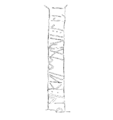TI·43
| Inscription | |
|---|---|
| Reading in transliteration: | ]ọni : kuimpaḷui : pạḷạ |
| Reading in original script: | ] |
| Variant reading: | ]ọni : kuimitṛui : pạḷạ ] |
|
| |
| Object: | TI·43 Bioggio (stela) |
| Position: | front |
| Orientation: | 90° |
| Frame: | ? |
| Direction of writing: | dextroverse |
| Script: | North Italic script (Lepontic alphabet) |
| Letter height: | 5–12 cm1.969 in <br />4.724 in <br /> |
| Number of letters: | 16 |
| Number of words: | 3 |
| Number of lines: | 1 |
| Workmanship: | carved |
| Condition: | incomplete |
|
| |
| Archaeological culture: | Golasecca III A, La Tène B, La Tène C |
| Date of inscription: | 5th–mid-2rd c. BC |
|
| |
| Type: | funerary |
| Language: | Celtic |
| Meaning: | 'pala for °u, son of Kuimpos' (?) |
|
| |
| Alternative sigla: | Morandi 2004: 300 |
|
| |
| Sources: | Morandi 2004: 717 f. no. 300 |
Images
|
Inscription TI·43 )ọni : kuimitrui : pạḷạ
|
Commentary
First published in Solinas 2002: 484–486, no. 1. Examined for LexLep on 19th October 2023.
Images in Solinas 2002: 484 (drawing), Morandi 2004: 720, fig. 39.300 (drawing) and 811, tav. XXXIV.300 (photo = [in colour] Wikipedia).
The fragment preserves the latter part of an inscription (length of the remains 100 cm) written running upward between frame lines (11.5–12.5 cm distance) which end in a stylised head without a neck; the bottom end of the frame is not preserved. The state of preservation of the letters is very good on the lower end (partly preserved omicron to mu), but deteriorates considerably toward the top. The letters are unequally spaced, with the engraver trying to save space around the problematic sequence after mu (see below), then filling out the rest of the frame comfortably with final pala, which is hardly legible (cf. Solinas 2002: 484). Omicron, whose second half only is preserved, is located in the lower part of the line, possibly under the bar(s) of the lost preceding letter? The first upsilon appears in a rare variant with the second line executed as a bar which meets the hasta at ca. a third of its height above the bottom line, cf. TI·35 and maybe TI·37. Solinas' original reading ]oni:kui?eḳṛui:pala was improved by Morandi, who identified the group of lines after the second iota as a very generously carved mu, whose four bars are executed as two half-circles hanging from the top frame line, with a distance of 1.5 cm between them and 2.5 cm between the first and the letter's hasta – no other reading is feasible (cf. TI·34.3, TI·30 and again TI·37). For the sequence after mu, Morandi suggests itrui rather than ekrui. Epsilon and kappa are indeed impossible; rho is highly doubtful as well, as the putative hasta and curve could be imagined to touch at the bottom only if the hasta is curved as well, and do not touch at the top. kuimitrui stands out as the only preserved second part of a name formula on a pala-stela which is not derived with -al-, and a reading of the difficult sequence as palui may be feasible. The group of lines after mu can be read as pi ![]() and alpha
and alpha ![]() rather than iota and somewhat wonky St Andrew's cross.The two putative hastae of alpha, however, do not touch at the top; /m/ should arguably not be written before a homorganic consonant, though the evidence for labial clusters is scarce. The forms of alpha in pala (Solinas: closed, Morandi: open) cannot be classified clearly. The bar of putative lambda
rather than iota and somewhat wonky St Andrew's cross.The two putative hastae of alpha, however, do not touch at the top; /m/ should arguably not be written before a homorganic consonant, though the evidence for labial clusters is scarce. The forms of alpha in pala (Solinas: closed, Morandi: open) cannot be classified clearly. The bar of putative lambda ![]() is difficult to make out with certainty. A reading kuimpalui is preferable from a linguistic standpoint; epigraphically, it is equally as problematic as kuimitrui (see the graphic above for a direct comparison). Whether the spelling of (*)/m/ before /p/ should be considered irregular is up for debate; while the non-spelling of (etymological) nasals before /t/ and /k/ suggests that it should, direct evidence for the cluster (*)/mp/ is absent, and exceptions do occur (see The Cisalpine Celtic Languages).
is difficult to make out with certainty. A reading kuimpalui is preferable from a linguistic standpoint; epigraphically, it is equally as problematic as kuimitrui (see the graphic above for a direct comparison). Whether the spelling of (*)/m/ before /p/ should be considered irregular is up for debate; while the non-spelling of (etymological) nasals before /t/ and /k/ suggests that it should, direct evidence for the cluster (*)/mp/ is absent, and exceptions do occur (see The Cisalpine Celtic Languages).
If the reading kuimpalui is correct, the inscription contains the standard text formula of Ticino gravestones with the name of the deceased in the dative (lost on-stem individual name in -oni plus patronym in -al-) and pala. If the second name is kuimitrui (uel sim.), it constitutes an irregular feature (cf. maybe TI·38 uosiu(). Considering that kuimitrui finds no comparanda in Gaulish onomastics, the surname may be overall not Celtic; a Celtic analysis for kuimpos is possible. See the word pages for details.
Dating based on the shape of the anthropomorphic frame according to the typology of De Marinis & Motta 1991: 206 (type B).
Bibliography
| De Marinis & Motta 1991 | Raffaele C. De Marinis, Filippo Motta, "Una nuova iscrizione lepontica su pietra da Mezzovico (Lugano)", Sibrium 21 (1990–1991), 201–225. |
|---|



